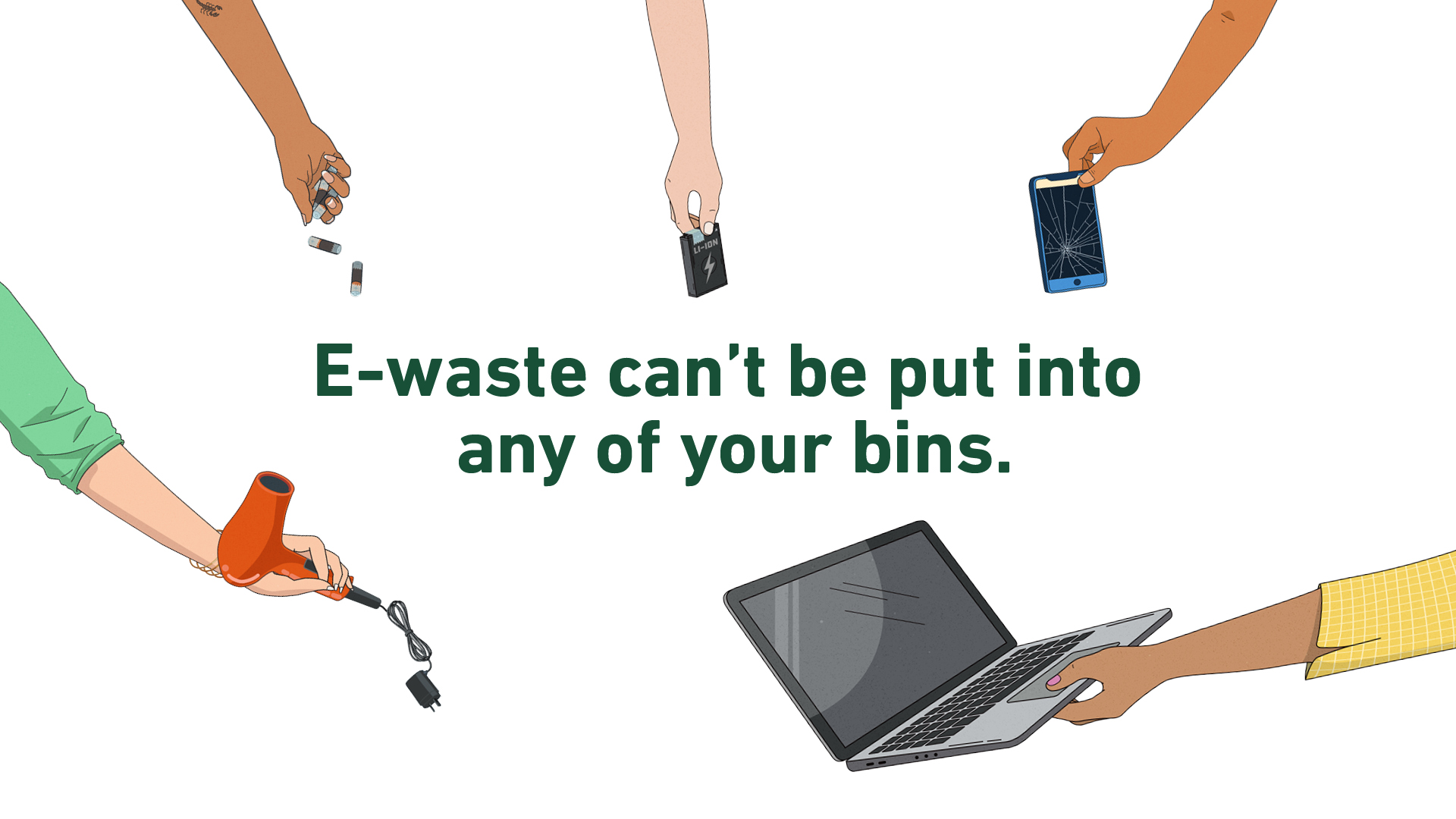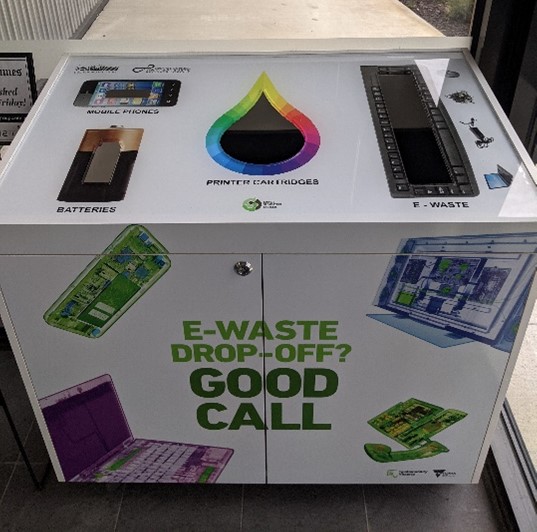
What is e-waste?
E-waste refers to any item with a plug, battery or cord that is no longer working or wanted. It covers a whole range of items found at work, home and even the garden shed.
E-waste is the world’s fastest growing category of waste. More than 62 million tonnes1 of e-waste was generated worldwide in 2022 with this figure expected to increase to 82 million tonnes2 by 2030.
Of this enormous figure, only about 22.3 per cent3 was estimated to be collected and recycled properly. The rest ends up in landfill.
Locally, the problem is significant, too. Australians are amongst the highest users and disposers of technology. E-waste is growing 3 times faster than general municipal waste in Australia. In Victoria, it is estimated that 256,000 tonnes of e-waste will be generated by 20354.
1,2 Projected electronic waste generation worldwide from 2019 to 2030
3 Global e-waste – statistics & facts
4 E-waste in Victoria
Never dispose of your e-waste in your kerbside collection bins
The Victorian Government introduced a ban on electronic items (e-waste) in any bin or landfill on 1 July 2019. This means that e-waste cannot be disposed of in either your general waste or your recycling bin.
When these materials are disposed in your kerbside collection bins, they can start a fire in the collection truck, at the recycling sorting facility, or at the landfill. E-waste can also contain hazardous materials that can leach into the soil and groundwater, or be released into the air, causing long term environmental damage and harm to human health.
Instead, e-waste should be recycled at participating transfer stations, recycling business and electronic stores.
See below for more details.
- Irons
- Toasters
- Coffee machines
- Hair dryers
- Watches
- Refrigerators
- Washing machines
- Cookers
- Microwaves
- Electric fans
- Air conditioners
- Computers
- Laptops
- Printers
- Mobile phones
- Televisions
- Remote controls
- Fluorescent lamps
- Compact fluorescent lamps
- LEDs
- Batteries
- Drills
- Saws
- Sewing machines
- Lawn mowers
- Electric trains and racing cars
- Hand-held video games
- Consoles
- Amplifiers
- Musical instruments
- Radios
There are two key reasons why e-waste should not be put in your bin:
Avoiding environmental contamination
Most e-waste contains hazardous materials. These can range from heavy metals such as lead, and mercury to ozone-depleting chlorofluorocarbons (CFCs) and flame retardants.
Even in small amounts, these dangerous chemicals can cause environmental contamination. However, when millions of e-waste items are dumped in landfill or stored inappropriately, the situation becomes much more serious.
They can leach dangerous amounts of hazardous substances into our groundwater, soil, and air. As these substances do not break down easily, it can result in long term environmental pollution.
Recovering valuable materials
E-waste contains a range of valuable materials, including tin, nickel, zinc, aluminium, copper, silver, gold and plastic. Recovering these preserves both their financial and utility value as well as reduces the need to mine new metals for new electronic products.
With correct techniques, up to 90 per cent of e-waste can be recycled with goal being a closed-loop. This means a new product isn’t made from raw materials, but instead from fully recycled components, which in turn are also completely recyclable.
Golden Plains Shire residents are encouraged to take their e-waste to the following sites for safe disposal.
You can also explore Council's new interactive waste sorting guide and community map to easily find the nearest e-waste recycling drop-off location. Access it here: Waste Sorting Guide | Golden Plains Shire Council.
| Drop-off location | E-waste accepted |
Golden Plains Civic Centre: 2 Pope Street, Bannockburn The Well - Smythesdale Business, Health and Community Hub: 19 Heales Street, Smythesdale | Household batteries, mobile phones, and other smaller e-waste items such as mice, keyboards and cables. Council also accepts printer cartridges for recycling.  |
Rokewood Resource Recovery Centre: 141 Meadows Road, Rokewood and is open from 10am to 3pm on Sundays (excluding public holidays, code red and total fire ban days). Ballarat Transfer Station: Gillies Street South, Ballarat Snake Valley Transfer Station: 298 Snake Valley-Mortchup Road, Snake Valley | All e-waste including mobile phones and batteries. |
| Woolworths stores | AA, AAA, C, D, and 9V sizes as well as mobile phones. |
| Officeworks stores | Accept most forms of e-waste including computers and laptop related equipment and mobile phones. |
| AA, AAA, C, D and 9V batteries. |
Businesses are encouraged to safely dispose of their e-waste by taking it to any of the following transfer stations:
- Rokewood Resource Recovery Centre: 141 Meadows Road, Rokewood and is open from 10am to 3pm on Sundays (excluding public holidays, code red and total fire ban days).
- Geelong Transfer Station: Douro Street, North Geelong
- Ballarat Transfer Station: Gillies Street South, Ballarat
- Snake Valley Transfer Station: 298 Snake Valley-Mortchup Road, Snake Valley
Alternatively, you can organise a collection with any of the following businesses*:
*The businesses listed above have agreed to be listed publicly on the Golden Plains Shire website. If you would like for your business to be listed here, please contact our Customer Experience team.
1. Items are manually disassembled: Depending on the type of device, some manual disassembly may occur. Batteries and casing are removed from phones and steel casing from around hard-drives. Cartridges and toners are detached from printers. The glass from TVs and monitors will be fully separated to avoid the release of any toxic lead or mercury that may be present.
2. Remaining components are shredded: After initial disassembly, the remaining items and components are sent to a shredder, which reduces the size of components to between 1cm and 10cm. Data destruction also takes place during this stage.
3. Shredded materials are sorted: Items are then manually sorted or sorted using automatic machines.
This includes using:
- Magnets to remove ferrous metals (steel, copper)
- Eddy currents to separate non-ferrous metals such as aluminium
- Infrared beams, lasers, x-rays and bursts of compressed air to identify various plastics and other metals
- Water to separate plastics from glass
4. Materials are resold to suppliers: Once all the materials have been sorted into their raw form, they can be resold to suppliers to make new products. 100% of e-waste is recycled and resources put back into the Australian Circular Economy.
With correct techniques, up to 90 per cent of e-waste can be recycled with the goal being a closed loop. This means a new product isn’t made from raw materials, but instead from fully recycled components, which in turn are also completely recyclable.
Recycling your e-waste is important and necessary. But even better is to try and avoid creating e-waste in the first place.
You can do this by:
- Carefully selecting the right product for your needs.
- Choosing a brand that's environmentally responsible.
- Only upgrading your tech if there's a real reason to do so.
- Learning about e-waste and the programs available to manage it.
- Supporting businesses that are working to solve the e-waste problem.
If you have an item you no longer need, but which still works and is in good condition, consider:
- Offering it to friends or family, or try swapping or giving it away for free via an online recycling site.
- Donating it to a charity or Not-For-Profit organisation – but first make sure they’re happy to accept it.
- Selling it. There’s a large market for quality second-hand electronics. You’ll make money and be helping reduce the e-waste burden.
If you have an item that no longer works, consider getting it repaired at one of the following Repair Cafes:
- Geelong Repair Café – Highton: St Lukes Uniting Church, Cnr Barrabool and Scenic Road, Highton. Contact them here: [email protected]
- Repair Café Surf Coast: Anglesea Memorial Hall, 1 McMillan Street, Anglesea, 3230. Operates the first Sunday of every month except January and June.
- Repair Café Ballarat: 25 Barkley Street, Ballarat East, VIC. Last Saturday of the month. Contact them here: [email protected].
The underlying reasons for the global growth in e-waste volumes are a complex combination of changing patterns of demand and faster turnover from the supply side.
Some of these factors include:
- Rapid innovation in both existing and new electronics.
- A decrease in built-in lifespan of electronic products.
- More affordable electronics increases accessibility and ultimately the amount of e-waste.
- More complex product design which makes repair and recovery more difficult – and more expensive.
The Global E-Waste Monitor reported that in 2022 only 22.3% of the world’s 62 million tonnes (Mt) of e-waste was documented to be collected and properly recycled, leaving US$62 billion worth of recoverable natural resources unaccounted for and increasing pollution risks to communities worldwide.
Worldwide, the annual generation of e-waste is rising by 2.6 million tonnes annually, on track to reach 82 million tonnes by 2030, a further 33% increase from the 2022 figure.
Used batteries are potentially hazardous, so they need to be stored and handled carefully.
- Keep batteries out of reach of children. Button cells (small round batteries) can be swallowed, causing choking or chemical burns.
- Be careful of damaged or leaking batteries. Some of the materials inside batteries are toxic and could result in poisoning.
- Keep batteries away from sunlight or heat. This may result in leakage of toxic materials.
- Reduce fire risk. Place individual batteries in a plastic bag or sleeve. Tape over the terminals of any lithium-based batteries, such as button cells; phone, camera and laptop batteries; and batteries with both terminals on one side (for example, 9V batteries).
For more information about the safe collection, storage, transport and handling of used handheld batteries refer to the Australian Battery Recycling Initiative guidelines.
